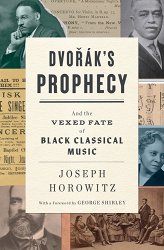SMOKEY BLUE´S AWAY
SMOKEY BLUE´S HOME AGAIN
by Norman Warwick

photo 1 In 1893 the composer Antonín Dvorák prophesied a “great and noble school” of American classical music based on the “negro melodies” he had excitedly discovered since arriving in the United States a year before. But while Black music would foster popular genres known the world over, it never gained a foothold in the concert hall. Black composers found few opportunities to have their works performed, and white composers mainly rejected Dvorák’s lead.
Joseph Horowitz ranges throughout American cultural history, from Frederick Douglass and Huckleberry Finn to George Gershwin’s Porgy and Bess and the work of Ralph Ellison, searching for explanations. Challenging the standard narrative for American classical music fashioned by Aaron Copland and Leonard Bernstein, he looks back to literary figures–Emerson, Melville, and Twain–to ponder how American music can connect with a “usable past.” The result is a new paradigm that makes room for Black composers, including Harry Burleigh, Nathaniel Dett, William Levi Dawson, and Florence Price, while giving increased prominence to Charles Ives and George Gershwin.
we´re gonna need a bigger bookshelf for book number13

Title Dvorak´s Propehecy
Author Joseph Horowitz
Price $30.00 $27.90
Publisher W. W. Norton & Company
Publish Date November 23, 2021
Pages 256
Dimensions 6.2 X 9.1 X 1.1 inches | 1.05 pounds
Language Englis
Type Hardcover
EAN/UPC 9780393881240

Dvorák’s Prophecy arrives in the midst of an important conversation about race in America–a conversation that is taking place in music schools and concert halls as well as capitols and boardrooms. As George Shirley writes in his foreword to the book, “We have been left unprepared for the current cultural moment. [Joseph Horowitz] explains how we got there [and] proposes a bigger world of American classical music than what we have known before. It is more diverse and more equitable. And it is more truthful.”

A former New York Times music critic, Joseph Horowitz (right) is the author of ten books exploring the history of American music, including Classical Music in America and Artists in Exile -both named books of the year by the Economist. He lives in New York City.
Dvorák’s Prophecy arrives in the midst of an important conversation about race in America–a conversation that is taking place in music schools and concert halls as well as capitols and boardrooms. As George Shirley writes in his foreword to the book, “We have been left unprepared for the current cultural moment. [Joseph Horowitz] explains how we got there [and] proposes a bigger world of American classical music than what we have known before. It is more diverse and more equitable. And it is more truthful.”

Story behind the song: The melody for “Goin’ Home” was written by the classical Czech composer Antonin Dvorak in 1893 as part of his Symphony no. 9: From the New World (a symphony loosely based on Longfellow’s poem “Song of Hiawatha”). In the early 1890’s, Dvorak was invited to teach for a four-year residency at the American Conservatory of Music in New York.
Dvorak was very interested in “peasant music” when he lived in Prague, and when he came to America, that interest transferred over to what he referred to as “negro melodies.” His copy assistant Harry Burleigh (an African-American) played a large role in introducing him to these folk songs. Dvorak began to promote the controversial idea that African-American music would be the future of America. He incorporated these musical themes into his own music, and admitted talented African-American musicians into his classes free of charge.
Now this idea of Black music as the “future of America” was controversial in a number of ways. Some, as you would expect, felt he was tainting the fine art of classical music by incorporating such a “lowly” art form. Others felt that Dvorak’s analysis wasn’t authentic, but based solely on some of the popular affectations of “negro melodies” written by white men (like Stephen Foster, for example)…I found this interesting piece in a May 30, 1893 article in the South Carolina paper, “The State”:
Had Dvorak, who is learned in music, been long in this country, he would know, as nearly everyone else knows, that none of the so called “negro melodies” is of negro origin…”The Swanee River,” “Nellie Gray,” “Massa’s in the cold, cold, ground,” and the other accepted melodies pertaining to Afro-Americanism are the creations of white men. Dr. Dvorak ought to spend a winter in Blake Township, Colleton County, or on Hilton Head Island. There he would hear genuine negro melodies. He can’t hear them in the concert halls of the North.

Nevertheless, Dvorak’s interest in African-American melodies (which did include spirituals like “Swing Low Sweet Chariot”) affected many in the music world. One of his students, William Arms Fisher (right), took his message to heart and began collecting, arranging, and publishing hundreds of African-American spirituals. He also wrote words to the Largo movement of Symphony no. 9, which became known as “Goin’ Home.”
I chose “Goin’ Home” for the last song of American Songs volume 2 because, despite the fact that it is not technically American music, but European, it was monumental in the way the world began to hear traditional American folk music. And thematically, all the songs on this new album have to do with traveling, moving, trying desperately to get to a place of hope, freedom, or love. How else could it possibly end?
Many of my generation know this music better as an accompaniment to a Hovis advert showing a bread-boy pushing his byke up a long cobbler hill in Hawarth, Lancashire or dog-food commercial showing an eclectic pack of `shiney-nosed, glossy coated dogs running happily through golden wheat-fields, although perhaps few of us might remember that the music was then recorded, with purposely written lyrics about a long lost dog called Smoky Blue making his way back home to his long-missed human family ! Perhaps only I remember it, …or mis-remember it. Was it actually a lyric to an advert ?
That particular movement of Dvorak´s entire work nevertheless complements other glorious melodies and dances within the piece, and does indeed evoke an aspirant new-world.
The original advert, which was recently voted ‘most iconic UK advert of all time’, was originally directed by Ridley Scott. It featured the Ashington Colliery brass band playing Dvořák’s Symphony No. 9 ‘From the New World’.
The music has now been re-recorded by the Ashington Colliery brass band, passing the baton down to a new generation of musicians.
The remastered ad, which will air on TV throughout June, has been digitally restored by the British Film Institute National Archive and RSA Films.
Jeremy Gibson, marketing director at Hovis, said the relaunch of ‘Boy on the bike’ represents the “iconic, family-focused nature of Hovis that is at the heart of everything we do.”
The advert shows a young boy, played by Carl Barlow, pushing his bike up Gold Hill in Dorset and delivering bread to the top of the cobbled street. Meanwhile, the narrator says the line: “T’was like taking bread to the top of the world – t’was a grand ride back though.”
Barlow, who was just 13 when the original ad was filmed, said: “This advert and Hovis have been such a huge part of my life and I am delighted it is coming back to the small screen.” He was paid £60 in 1973 to appear in the now-iconic advert.
Robin Baker, head curator at BFI National Archive, described the ad as “one of the most potent, popular and iconic films in British advertising history”.
He continued: “‘Boy on the bike’ is a mini-masterpiece of big, nostalgic emotion, but the original elements have been ravaged by time. It is now fully restored to its former glory for new generations to enjoy. It looks and sounds as good today as it did in 1973.”
Still, though, I can hear in my head a lyrical line that accompanies the New World Symphony Opus 9 music but the voice I hear is not mine (its in tune) and nor is it the voice of Colin Lever, my Lendanear song-writing partner, so I´m pretty damned certain we didn´t write it. Who did, though?
I am convinced, though, that Smokey Blue is out there somewhere. It you hear it, please let me know where I might find it.
can contact me at normanwarwick55@gmail.com


Leave a Reply
Want to join the discussion?Feel free to contribute!